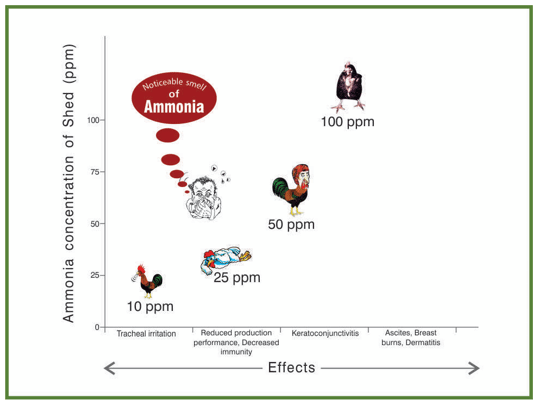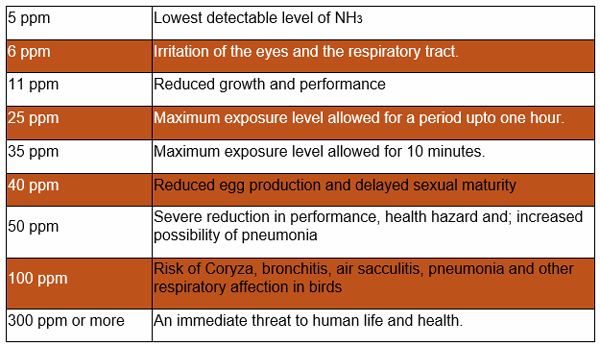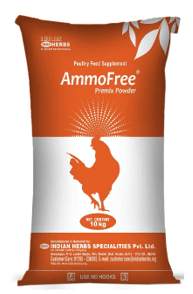Ammonia emissions in poultry barns and management strategies
Published: December 6, 2022
By: Dr. Shivi Maini,
General Manager Technical
Indian Herbs Specialities Pvt. Ltd.
One of the biggest complaints surrounding the poultry houses is the smell of manure. The ammonia concentration in poultry houses not only contributes to the smell but can be harmful for both the birds and the workers who frequent the barn. This article is about how ammonia gas is formed, its impact on the birds and how to control ammonia levels in poultry houses.
Ammonia emission in poultry houses
Ammonia emission is one of the greatest concern in poultry houses. Ammonia in a poultry house comes from the birds themselves. Unused nitrogen is excreted as uric acid (80%), ammonia (10%), and urea (5%). When ammonia gas is exposed to moisture, it reacts and forms a basic, corrosive solution called ammonium. This aqueous ammonium solution causes harm to birds. The ammonium corrodes the lining of chickens’ respiratory tract and paralyses or even destroys the cilia of the epithelial cells. In such conditions, the mucus on the mucosal surface of the trachea cannot be cleared by the cilia and thus bacteria become trapped. When the bacteria reach the lungs or the air sacs, they cause infections.
Considering both human and animal health, guideline exposure levels for ammonia is set to 20-25ppm in many countries. However, in practice, the concentration of ammonia in some broiler houses may easily exceed 30-70 ppm, particularly in wintertime. The EU directive (Council Directive 2007/43/EC) states that the NH3 concentration should not exceed 20 ppm over any eight-hour period or 35 ppm over any ten-minute period during the poultry production cycle.
Impact on poultry health and welfare
Many researchers reported that NH3 in poultry houses lowers performance and may increase disease susceptibility. Ammonia enters blood stream as a result of nitrogen metabolism or by breathing air containing high levels of ammonia. The negative effects of ammonia on animals begin at 20 ppm and become very serious at 100 ppm. Chickens generally show the symptoms of ammonia exposure at 4-5 weeks of age. The symptoms of ammonia irritation may include watery eyes, closed eyelids, conjunctivitis, blindness, sinusitis, starvation etc. The adverse effects on growth rate and FCR alongwith higher incidence of breast blisters and carcass condemnations, result in serious economic losses to the farmers. Ammonia lessens the activity of the ciliary epithelium of the respiratory tract and predisposes the animals to coryza, bronchitis, air sacculitis, pneumonia and other respiratory affections. Chickens exposed to 20 ppm of ammonia for 42 days show pulmonary congestion, edema and hemorrhage. Chickens exposed to 40 ppm ammonia exhibit a lower ability to clear E.coli from their system, making it unsafe for human consumption. At 50 ppm, the rate of infection of Ranikhet Disease is doubled. Ammonia exposure also leads to reduced egg production and delayed sexual maturity. A slight odour of ammonia or 10% increase of ammonia in the air of animal shed can reduce weight gain by 1% to 2%. Noticeable nose and eye irritation due to ammonia reduces growth and body weight upto 25%, leading to increased incidences of diseases and mortality.
Harmful effects of ammonia concentrations in poultry


Management Practices for Reducing Ammonia Emissions
Ventilation during cold weather is always inadequate & challenging because there is excessive calorie burn in birds to combat cold stress. To prevent excess calorie burn, ventilation is minimized so that poultry house temperature can be maintained and high flock performance can be achieved. One negative effect of tightly controlling ventilation in the winter is the potential to increase the concentration of ammonia in houses. Higher level of ammonia in animal houses may be due to excess production of ammonia or its lower diffusion. Wet litter due to physiological or mechanical causes may also aggravates ammonia production in the animal house.
There are several strategies for decreasing ammonia in the barn. These strategies can be used individually or in combination and can help encourage good barn air quality and better poultry performance potential. These strategies include ventilation and management of both the barn and the poultry litter/manure. Good barn management can also help to diminish the formation of ammonia gas.
Strategies for managing the litter and manure
Managing the bird diet: The formation of ammonia in the manure and its subsequent release as a gas can be traced back to increased nitrogen levels in the manure. Fecal nitrogen levels can increase if the bird does not properly break down and absorb the protein in the feed. This can happen if the bird’s diet features too much complex protein, or if the bird is sick. These issues can be prevented by balancing the protein or amino acid levels in the diet and by maintaining the bird’s gastrointestinal health.
Another method to help prevent ammonia emissions from nitrogen within the feces is to use phytogenic ingredients that plays a role in binding ammonia. Many phytoingredients have been reported to reduce blood urea and blood ammonium ions, reduce excessive nitrogen breakdown in the ceca and bind ammonia so it stays in the manure instead of being released as gas.
Many researchers reported that feeding of the saponins to livestock had shown to reduce feacal odour alongwith reduction in emission of volatile compounds. In the studies conducted with feeding of steroidal saponins to poultry caged layer, ammonia levels decreased by 35% and average egg weight increased from 58 gms to 62 gms and broiler chickens grew significantly heavier. The saponins condition the cell membranes and reduce surface tension to help better absorption of nutrients in cell membranes. Intestinal ammonia level has a significant influence on ascites mortality in broilers. Inclusion of saponins in the diet reduces mortality due to ascites in broilers like urease inhibitor. Feeding of saponin to pigs resulted in faster body weight gain and improved feed efficiency.

AmmoFree is a natural animal feed supplement to effectively control the production and emission of ammonia and other noxious gases. The natural AmmoFree contains steroidal saponins and active glyco-compounds, which support and enhance the intestinal enzyme system. When added to the diet, the active saponin components of AmmoFree pass through the digestive tract unabsorbed and are excreted in the feaces. In the excreta, the saponins bind to ammonia and other odiferous compounds and prevent them from being released into the air. These saponins also increase the utilization of Ammonia nitrogen in the G.I. tract by stimulating favourable microbial growth.
It is evident on basis of scientific and commercial farm trials that Ammofree supplementation to poultry birds provide unique benefits of efficiently absorbing ammonia and other noxious gases and thus reducing emission of ammonia, hydrogen sulfide etc. which are detrimental to animal health and environment. It augments healthy gut microflora and optimizes the process of digestion and absorption for full utilization of nutrients, reduces environmental and systemic ammonia concentration, which ultimately lowers susceptibility to diseases and improves growth, FCR and livability of the animals. Unique phyto-ingredients of AmmoFree act as a detergent that cleanses not only the general surfaces of intestine, but also deep around the villi, thus removing the accumulated harmful toxins that contribute to toxaemia leading to many degenerative diseases.
Indian Herbs Specialities conducted a number of trials over the past few winters to compare efficacy of Ammofree and its ability to reduce ammonia levels to acceptable levels in cage-free layer houses and in deep litter system. Several published research trials have established the benefit of adding Ammofree to diets to reduce aerial ammonia concentrations. At low ambient temperature during winter, when issues with higher ammonia levels are a challenge, Indian Herbs Specialities recommend addition of product Ammofree to diet to help combat increased ammonia levels.
Related topics:
Authors:
Indian Herbs
Recommend
Comment
Share
6 de febrero de 2023
Too much ammonia kills birds. So how do you prevent high mortalities if you're hit by too much ammonia content inside your poultry house?
Recommend
Reply

Would you like to discuss another topic? Create a new post to engage with experts in the community.
Featured users in Poultry Industry

Shivaram Rao
Pilgrim´s
PhD Director Principal de Nutrición y Servicios Técnicos de Pilgrim’s Pride Corporation
United States
United States







